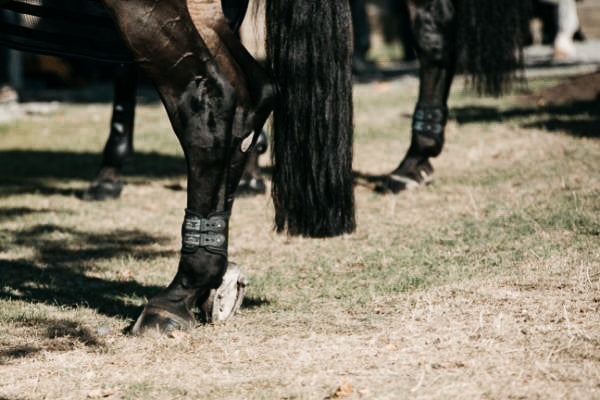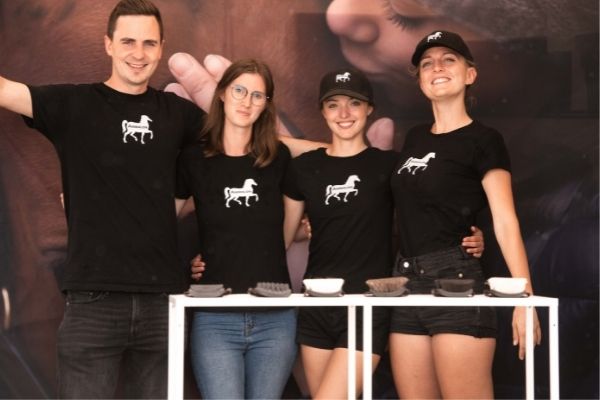
Late – the “end” for your beloved riding horse?
As long as our horses play happily in the pasture and move freely and contentedly under the rider, all is well with us.
But what if our beloved riding horse starts to lame? And then she comes. The vet's diagnosis: Late. Ignorance and fears are spreading.
Where does that come from? Is my friend suffering a lot?
What can I do for him?
What are the chances that my horse will be rideable again with this horse disease?
All legitimate questions that we would be happy to try to answer for you.
Possible causes
- Overload (bruises, compressions, twisting, strains)
- frequent tearing, pulling and twisting forces can cause spasm in the horse
- too much demand for a meeting too quickly
- Injuries (kick)
- Bone cysts
- Mineral deficiency or overdose of minerals as a young animal
- possibly. genetically determined
- Position error (e.g. b. cow-hock or saber-legged position)
Where does it hurt on a riding horse?
When spat occurs in horses, the joint (osteoarthritis), the bones (periostitis) and, in some cases, the periosteum become inflamed. Inflammatory substances can affect soft tissues (e.g. b. tendon, bursa). As a rule, smaller, movable joints in the horse's hock become inflamed. If a chronic course develops, the joint surfaces are destroyed. New bone material forms. Joint spaces can narrow, close and become stiff. But then the animal is lame-free.
On the other hand, no formations grow with osteolytic spat. In this case, the bones decalcify.
The pain of the disease is usually located in the joint bones between the cannon bone and the heel bone in the horse's hock. This is where late inflammation most often occurs.
Recognize symptoms
- Tension in the back area
- hind legs turning outwards
- shortened steps
-Hoofs are only given reluctantly (especially when staying for a long time)
- Lameness usually from rest to movement (horse runs in)
- persistent lameness (advanced spat)
- The affected leg is protected when standing
- Thickenings or Growths (spathe humps) usually in the inner area of the ankle joint
- Hind hooves drag on the ground (often evident from the wear of the horseshoes or bare feet)
How does the vet diagnose this horse disease?
At the beginning your doctor will carry out a so-called late test. He bends the hind leg (hock) high. Then he lets your horse trot immediately. If lameness is noticeable during the first steps, this is an indication that the horse is spasmodic.
Joint anesthesia is used as reliable evidence. An anesthetic is injected into the joint. If the lameness has disappeared, it is clearly a spat disease.
Of course you can also have your animal x-rayed. Bone scintigraphy reveals pathological changes in the bones.
Which treatment for the horse?
Unfortunately, this horse disease is incurable. Bone changes cannot be reversed.
The following applies:
- to relieve pain in the horse
- Eliminate lameness
- to contain or at best stop the process on bones and joints
Forms of therapy
As a rule, anti-inflammatory preparations and painkillers are injected into the joint at the beginning. Rubs that stimulate blood circulation are also said to stimulate metabolism and thus promote stiffening of the joint.
Shock wave therapy has often achieved success. This also stimulates blood circulation.
Furthermore, the animal's own substances (taken from the blood) can be used. They are injected in concentrated amounts into affected areas of the horse's hock and positively support the regeneration of bone tissue.
For osteolytic spasms, horses may need surgery as treatment. Bone formation is stimulated via arthrodesis (drilling into the bones). Goal: The joint stiffens.
A spade shoe can be used as a hoof correction. This is individually adapted to the riding horse by a farrier. Wide-leg irons are usually used, which are intended to relieve the inner joint space. The irons are bent up at the toe. This makes unrolling easier. In extreme cases, cushioning hoof plates between the iron and the hoof are also necessary. A spade shoe (iron or plastic) allows your horse to move more easily and in a more stable manner.
Nevertheless, a spade horse can be barefoot on suitable ground. As natural as possible is often better anyway. So iron is not a must. If you use hoof shoes, you could also use cushioning cushions. However, it makes sense to consult with a sensible hoof trimmer in order to choose the best option for the affected horse.
Alternative medicine e.g. b. Homeopathy, herbalism, leech therapy, acupuncture and magnetic field therapy can stimulate a lot in cell metabolism. It is advisable to find a good veterinary practitioner. These methods are always helpful.
Movement is a must! In fact, late patients in particular should not necessarily live in a box. The open or loose stable is exactly the right form of housing for these animals. Lots of walking is ideal and beneficial. As a light rider, you can even continue to ride your horse. A lot of walking and once it has broken in, a careful trot is also permitted.
The amount of exercise will of course be discussed with the vet beforehand. Devil's claw, ginger or white willow can also be fed.
Can you prevent this horse disease?
Yes. Make sure you have an optimal supply of minerals when feeding. Even with young horses, mind you! If in doubt, ask a veterinarian or nutritionist.
Also pay attention to correct, regular hoof trimming. Positioning errors can be prevented as early as foal age.
Train through gymnastics and build muscles (a muscled hindquarters takes the strain off the horse's hock). Do not overwhelm your animal and always warm it up well.
Sad on a horse doesn't mean the end. You'll be relieved, right? Sure, it's a limitation. But your friend is worth handling with care. After all, he still remains the same loving cuddly cheek. Rides together (adjusting the pace, tar surfaces or Avoid hard surfaces) there is actually nothing in the way.
Discover more posts

Animalon helps you and your horse change their fur
As you probably know, a horse's coat change means peak performance. But the change to the new coat also presents us with quite a few challenges when it comes to horse care. It's not just the h...
Continue reading
We will continue in the “trade fair” area in 2020 – we will be represented as an exhibitor at Partner Pferde for the first time. We are very pleased to be able to set up our stand in Leipzig t...
Continue reading
